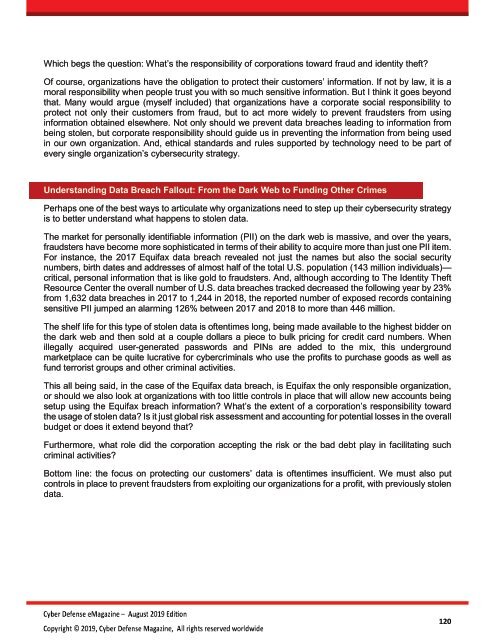Cyber Defense eMagazine August 2019
Cyber Defense eMagazine August Edition for 2019 #CDM #CYBERDEFENSEMAG @CyberDefenseMag by @Miliefsky a world-renowned cybersecurity expert and the Publisher of Cyber Defense Magazine as part of the Cyber Defense Media Group
Cyber Defense eMagazine August Edition for 2019 #CDM #CYBERDEFENSEMAG @CyberDefenseMag by @Miliefsky a world-renowned cybersecurity expert and the Publisher of Cyber Defense Magazine as part of the Cyber Defense Media Group
You also want an ePaper? Increase the reach of your titles
YUMPU automatically turns print PDFs into web optimized ePapers that Google loves.
Which begs the question: What’s the responsibility of corporations toward fraud and identity theft?<br />
Of course, organizations have the obligation to protect their customers’ information. If not by law, it is a<br />
moral responsibility when people trust you with so much sensitive information. But I think it goes beyond<br />
that. Many would argue (myself included) that organizations have a corporate social responsibility to<br />
protect not only their customers from fraud, but to act more widely to prevent fraudsters from using<br />
information obtained elsewhere. Not only should we prevent data breaches leading to information from<br />
being stolen, but corporate responsibility should guide us in preventing the information from being used<br />
in our own organization. And, ethical standards and rules supported by technology need to be part of<br />
every single organization’s cybersecurity strategy.<br />
Understanding Data Breach Fallout: From the Dark Web to Funding Other Crimes<br />
Perhaps one of the best ways to articulate why organizations need to step up their cybersecurity strategy<br />
is to better understand what happens to stolen data.<br />
The market for personally identifiable information (PII) on the dark web is massive, and over the years,<br />
fraudsters have become more sophisticated in terms of their ability to acquire more than just one PII item.<br />
For instance, the 2017 Equifax data breach revealed not just the names but also the social security<br />
numbers, birth dates and addresses of almost half of the total U.S. population (143 million individuals)—<br />
critical, personal information that is like gold to fraudsters. And, although according to The Identity Theft<br />
Resource Center the overall number of U.S. data breaches tracked decreased the following year by 23%<br />
from 1,632 data breaches in 2017 to 1,244 in 2018, the reported number of exposed records containing<br />
sensitive PII jumped an alarming 126% between 2017 and 2018 to more than 446 million.<br />
The shelf life for this type of stolen data is oftentimes long, being made available to the highest bidder on<br />
the dark web and then sold at a couple dollars a piece to bulk pricing for credit card numbers. When<br />
illegally acquired user-generated passwords and PINs are added to the mix, this underground<br />
marketplace can be quite lucrative for cybercriminals who use the profits to purchase goods as well as<br />
fund terrorist groups and other criminal activities.<br />
This all being said, in the case of the Equifax data breach, is Equifax the only responsible organization,<br />
or should we also look at organizations with too little controls in place that will allow new accounts being<br />
setup using the Equifax breach information? What’s the extent of a corporation’s responsibility toward<br />
the usage of stolen data? Is it just global risk assessment and accounting for potential losses in the overall<br />
budget or does it extend beyond that?<br />
Furthermore, what role did the corporation accepting the risk or the bad debt play in facilitating such<br />
criminal activities?<br />
Bottom line: the focus on protecting our customers’ data is oftentimes insufficient. We must also put<br />
controls in place to prevent fraudsters from exploiting our organizations for a profit, with previously stolen<br />
data.<br />
120


















